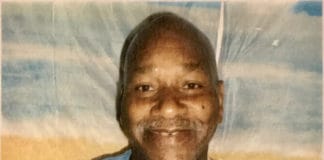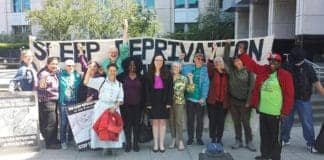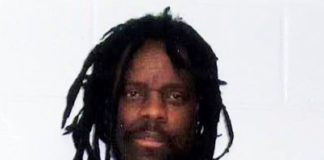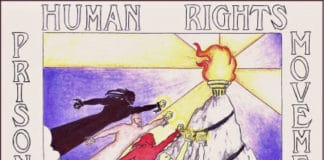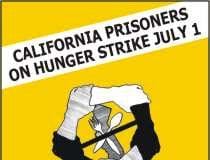Tags Marie Levin
Tag: Marie Levin
Liberate the Caged Voices: Free Sitawa!
Sitawa, along with three other strong and principled leaders of the Pelican Bay Short Corridor Collective, inspired 30,000 courageous prisoners, who, in their struggle for freedom from the torture of solitary confinement – or the threat of it – chose to shun violence and rather embrace a peaceful strategy in order to bring about much needed change.
Lost in time: Lift up our brother Sitawa and strike down...
Sorrow is felt among the whole prison population for our brother Sitawa Nantambu Jamaa, who, along with countless fearless prisoners, pioneered our Prison Human Rights Movement (PHRM) to the world’s stage leading the largest-in-history California hunger strikes, yet he continues to be held indefinitely. The prison system is covertly executing all of its lifers.
Rally in solidarity: Join the California Hunger Strikes’ four ‘main reps’...
Rally at the San Francisco Federal Courthouse while the four California prisoner hunger strike and Ashker class representatives meet and confer* with CDCr to address the continuing solitary conditions that violate the Ashker lawsuit settlement agreement. The four prisoner hunger strike representatives will be present in the courtroom, an historic presence! Help create a strong show of solidarity with prisoners fighting for human rights! Join the rally outside the courthouse on Tuesday, Aug. 21, 2018, 11:30 a.m., at the Phillip Burton Federal Building and U.S. Courthouse, 450 Golden Gate Ave., San Francisco.
Together to End Solitary: ‘Cruel and Unusual, the Story of the...
On April 22, 2018, over 200 people attended the UCSC opening of the Reel Work May Day Labor Film Festival (RWLFF)’s 17th season, with the event theme “Together to End Solitary.” RWLFF’s motto, “We are stronger together,” is particularly poignant when coming together to end the extreme isolation of the state-sanctioned torture of solitary confinement. The film, “Cruel and Unusual, the Story of the Angola 3,” details the Angola 3's decades-long struggle for justice and to build an international movement to end solitary confinement.
Judge skeptical of CDCr’s excuses for sleep deprivation in solitary confinement
A number of hardy souls ventured to Sacramento on May 18 to a federal court hearing on CDCr’s motion to dismiss Jorge Rico’s suit opposing the every-half-hour Guard One “security/welfare checks” that take place in isolation units throughout the state. With Guard One, guards press a metal baton into a metal receiver positioned either in or beside cell doors, making a loud disruptive noise in most cases, waking prisoners up every 30 minutes and causing sleep deprivation.
‘Solitary Man’ play and panel at the Black Rep – pain,...
On April 21, I finally got to see Charlie Hinton’s “Solitary Man” play at the Black Repertory Theater in Berkeley. It was so much more than a cultural experience. The play was gripping, emotional and real, with jazz trumpet sprinkled in. The panel powerfully reflected the layers of pain, survival and resistance in the prison movement. And the event, a benefit for the San Francisco Bay View, was a moving tribute to Mary and Willie Ratcliff’s devotion to their invaluable newspaper.
We know a benefactor will save the Bay View the way...
I’m writing this editorial because I want to brag on my husband, Bay View publisher Dr. Willie Ratcliff, and tell you why he and I have faith that a benefactor, someone with deep pockets who cares, will step forward in time to save the Bay View and keep it in print – an angel who understands how much the Bay View means to a prisoner being tortured and a youngster in the hood being framed. Dr. Ratcliff was that angel, that benefactor, to Gladys Knight in 1975, when she ran out of money in the midst of producing a major film in Valdez, Alaska called “Pipe Dreams.”
Brutha Sitawa: CDCr and Soledad Prison retaliate with false reports to...
For years now, I have endured threats, both overt and covert, from the mouths and hands of CDCr’s (California Department of Corrections and rehabilitation’s) OCS (Office of Correctional Safety), ISU (Investigations Services Unit) and IGI (Institutional Gang Investigations), all of them paramilitary services that boast they are a gang and call themselves the Green Wall. (See my article “Sitawa: Exiting solitary confinement – and the games CDCr plays.”)
CDCr must effect genuine changes in its old policies, culture and...
As always, allow us to begin by paying our respects to the families who lost their loved ones during the historic California hunger strikes. Prior to the solidarity hunger strikes, the four principal negotiators, Sitawa Nantambu Jamaa, Arturo Castellanos, George Franco and Todd Ashker, found ourselves locked inside Pelican Bay SHU Short Corridor. There we would discuss the vision of effecting genuine change in CDCr’s long term solitary confinement combined policies, practices and conditions.
A solitary distinction
Since our historical release from solitary confinement, many of us have been bombarded by the same question: How did you (we) survive decades of being in solitary confinement? This is not a question of simplicity, it is only a qualitative and quantitative prelude into an analysis rooted in a historical material construct which would require a compartmentalization of the particulars which are conducive towards providing an accurate response to the above question with both clarity and purpose.
Prisoner Human Rights Movement Blue Print
CDCr has systemic and dysfunctional problems that run rampant statewide within California’s prisons for both women and men which demand this California government to take immediate action and institute measures to effect genuine tangible changes throughout CDCr on all levels. The Prisoner Human Rights Movement Blue Print is essentially designed to deal with identifying and resolving primary contradictions by focusing on the various problems of CDCr’s dysfunction.
Women’s prisons as sites of resistance: An interview with Victoria Law
Too often, organizing work done by incarcerated women goes wholly unrecognized. In her book, “Resistance Behind Bars: The Struggles of Incarcerated Women,” Victoria Law focuses on the many forms of activism happening inside of women’s prisons, most of which never reach the dominant media. In the following interview, Law shares ways in which individual acts of resistance are building toward a transformational new reality.
California prisoners win historic gains with settlement against solitary confinement
Today, California prisoners locked in isolation achieved a groundbreaking legal victory in their ongoing struggle against the use of solitary confinement. A settlement was reached in the federal class action suit Ashker v. Brown, originally filed in 2012, effectively ending indefinite long-term solitary confinement and greatly limiting the prison administration’s ability to use the practice, widely seen as a form of torture.
On the 23rd of every month, Californians demand, ‘End solitary confinement!’...
On May 23, 2015, families and loved ones of people in solitary, community organizations and prisoner-class human rights advocates once again mobilized Statewide Coordinated Actions to End Solitary Confinement (SCATESC) throughout California and in Pennsylvania. Since the actions began on March 23, 2015, over 30 organizations – statewide, nationwide and worldwide – became co-sponsors, 45 endorsed, and the movement keeps growing.
The first monthly Statewide Coordinated Actions to End Solitary Confinement held...
Statewide Coordinated Actions to End Solitary Confinement (SCATESC) began March 23, 2015. Actions were held in California from San Diego to Arcata (Arcata-Eureka, Los Angeles, Oakland, San Diego, San Jose, Santa Cruz) and Philadelphia, Penn. Activists in more locations will be joining in on April 23 and the 23rd of each month. Below is a report from just one locality, Santa Cruz, which took a creative approach.
California’s savage system of confinement: An end to solitary is long...
Less than two weeks ago the United Nations Committee against Torture issued a report strongly criticizing the U.S. record on a number of issues, among them the extensive use of solitary confinement. While the U.S. uses long-term solitary more than any other country in the world, California uses it more than any other state. This practice is designed to break the human spirit and is condemned as a form of torture under international law.
California Department of Corrections and Rehabilitation tries to fast track draconian...
Claiming the need for emergency passage of new visiting policies, the California Department of Corrections (CDCR) is proposing the use of canines and ION scanners that would subject visitors to prisons to humiliating and traumatizing strip searches. The move has brought swift condemnation from prisoner advocacy organizations and groups that work with prisoners, including the Prisoner Hunger Strike Solidarity Coalition (PHSS).
To celebrate the movement: The California prisoner hunger strike one year...
One year ago on July 8, 30,000 California prisoners refused meals and work assignments, beginning a 60-day hunger strike with the core demand of ending the state’s use of indefinite solitary confinement. This was the largest hunger strike in U.S. history, and it presented the deepest challenge yet to solitary by bringing national and international attention to a practice that has long been condemned by human rights groups as torture.
Lawyers Guild honors prison hunger strikers
On the evening of April 5, hundreds gathered in downtown Oakland for the National Lawyers Guild San Francisco Bay Area Chapter’s (NLGSF) annual fundraising dinner. This year, the NLGSF honored California prison hunger strikers and the Prisoner Hunger Strike Solidarity (PHSS) coalition of family members, activists and friends who supported the strikers. The assembled crowd was able to hear directly from those inside California prisons.
Prison hunger strikers face reprisals as papers that back them are...
Since some 30,000 California prisoners launched a hunger strike July 8 against the practice of long-term solitary confinement and other abuses, participants have faced punitive retaliation and censorship of newspapers and other media that backed their fight. Abuses continued after prisoners suspended the strike Sept. 5.




